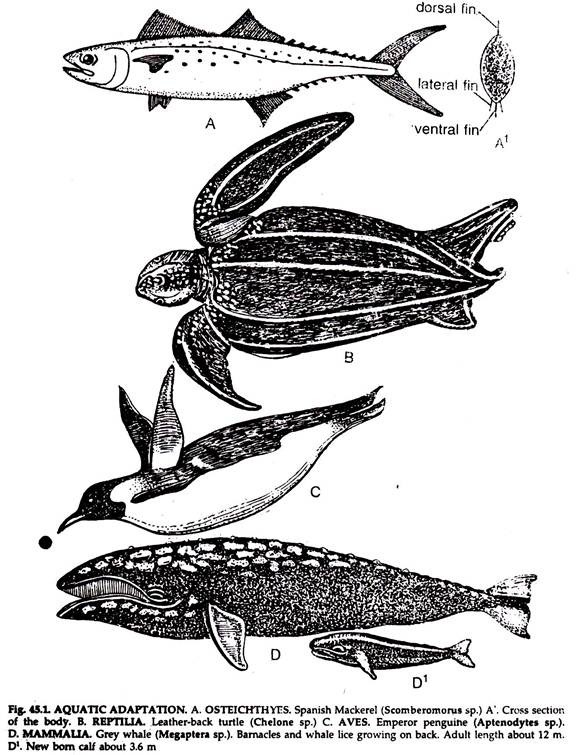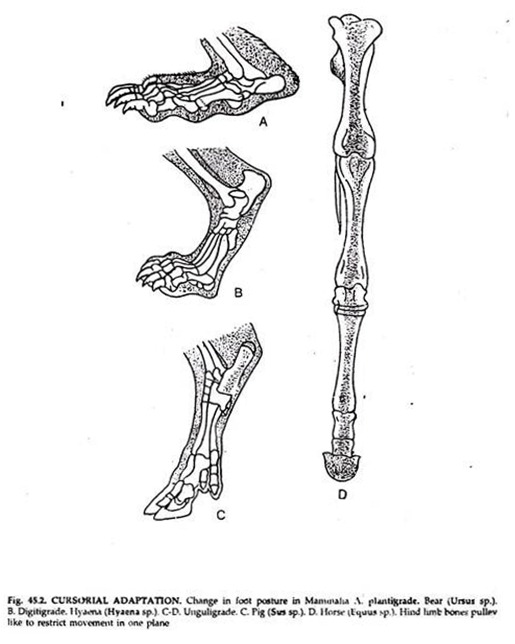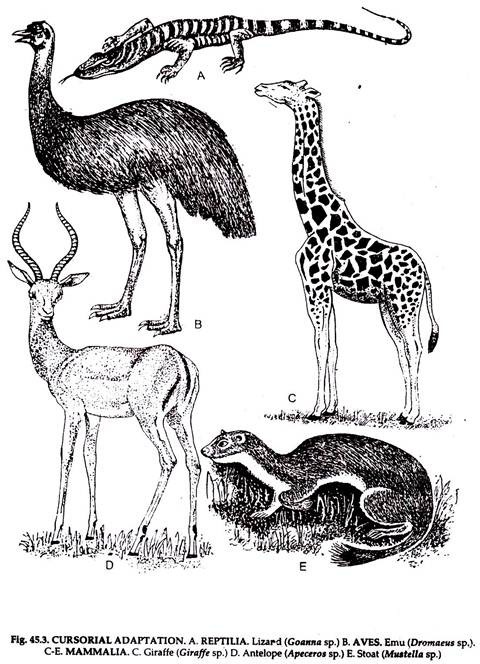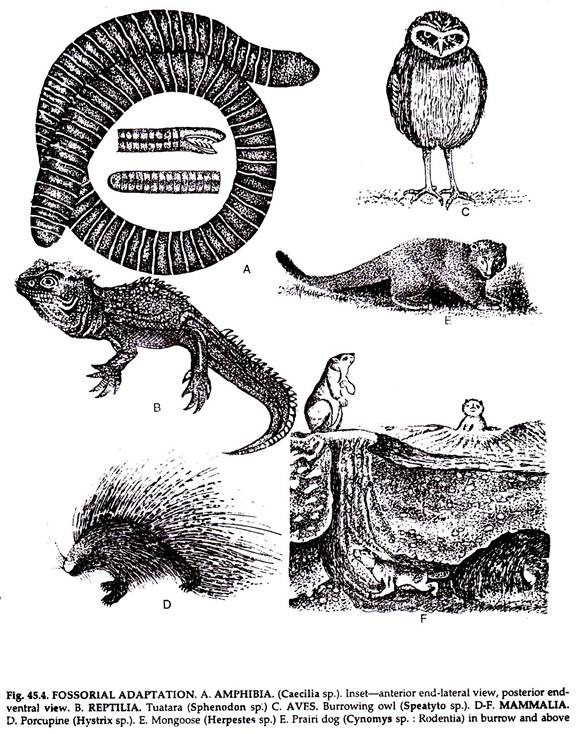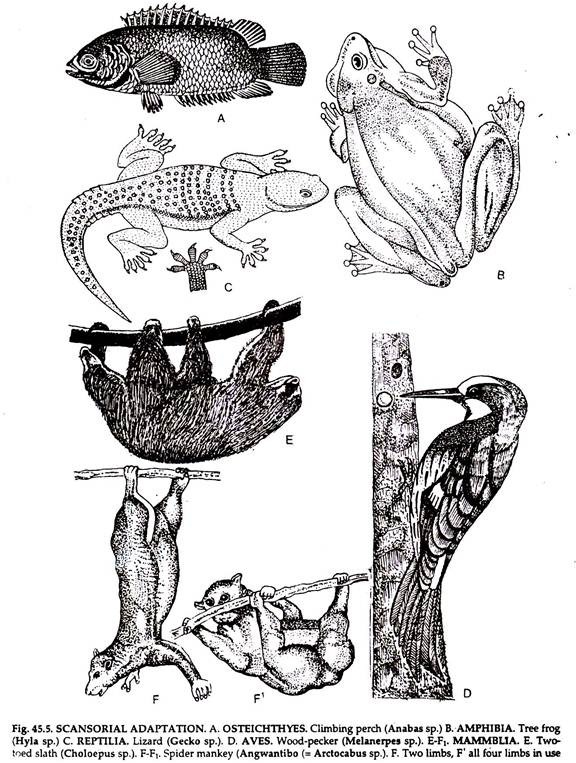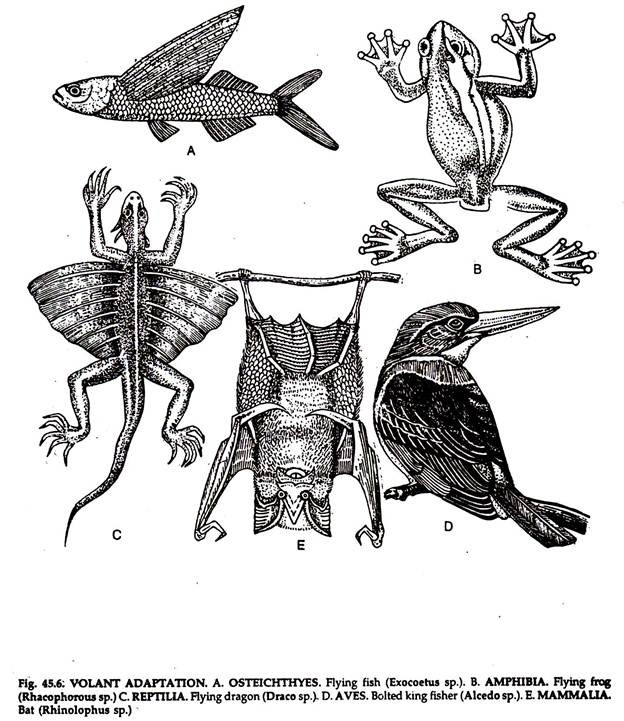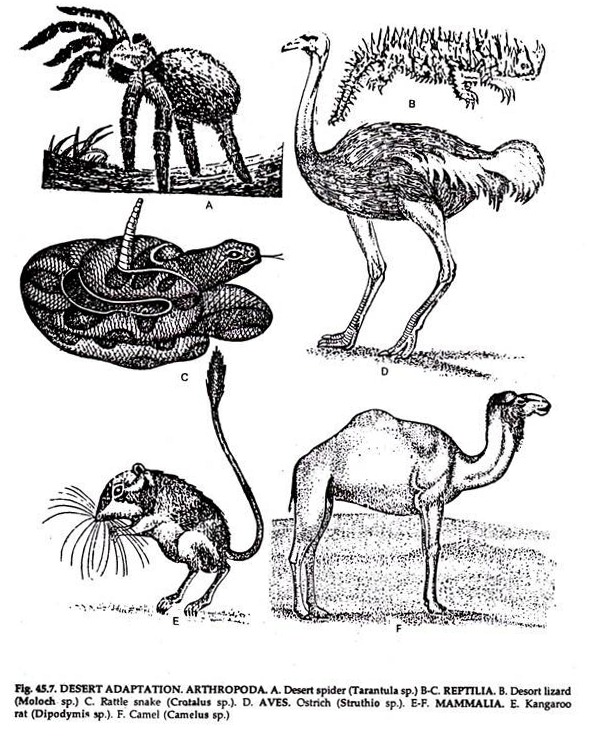The below mentioned article provides biology notes on adaptation in animals.
The changes in the organism by which it suits best in the environment and leave behind offspring’s are known as adaptation. Had there been no adaptation, evolution would have been impossible. The earth and all the earthly things are under constant change.
The capability of an organism to change itself with the changing world determines its survival. Greater the degree of adaptation, higher is the ability to exploit the environment resulting in the production of greater number of offspring’s and consequent higher chances of survival of the species.
The adaptation may be of two types:
ADVERTISEMENTS:
Primary and
Secondary (acquired).
Primary adaptation:
The adaptations remain in the original direction and the subsequent changes remain more or less in the same direction from the very appearance of the animal. Example: Aquatic adaptation of fish.
ADVERTISEMENTS:
Secondary (acquired) adaptation:
The adaptive changes deviate from the original direction. The changes are diverted along different lines due to change of the original home of the organisms and they subsequently adapt themselves to some new environment.
Example: Aquatic adaptation of whales.
Convergence and divergence:
ADVERTISEMENTS:
Animals belonging to different groups living under similar life conditions show similar adaptation. This is known as convergence or parallelism. Animals belonging to same stock migrate to different geographical areas to meet their need for food and safety and are subjected to different life conditions. This leads to varied and diverse adaptations. This is called divergence.
From a primitive stem the animals move out in four different directions and are adapted to aquatic, amphibious, terrestrial and arboreal life. Adaptation in a particular environment may again be of different types.
From environmental point of view following and other adaptations are found in the animals.
Aquatic adaptation:
Adaptation to water medium. Water is the densest homogeneous medium and adaptations to aquatic life (Fig. 45.1) are necessarily directed to minimise the resistance during movement.
Modifications:
Modifications are much less in primary aquatic forms but extensive in secondary aquatic ones.
Primary aquatic adaptation:
ADVERTISEMENTS:
1. Head, body and tail compressed into a spindle-like form (Fig. 45.1A, A’).
2. The head is wedge-shaped, the edges of the jaws and gill covers fit perfectly.
3. Locomotion by lateral undulation of the body aided by the fins.
4. Hydrostatical air bladder to maintain a plane of flotation.
Examples: All fishes. Secondary (acquired) aquatic adaptation
Modifications of structures are extensive in secondarily adapted aquatic forms. Ancestors of these animals were terrestrial lung breathers. Search for safety and competition for food presumably forced them to move to water, to which they have been subsequently adapted with a remarkable degree of success.
1. The body contour spindle-shaped, neck constriction disappears and the tail enlarges.
2. The neck becomes shorter.
3. The chest tends to become cylindrical.
4. External ears lost.
5. External nostrils shift towards the apex of the head.
6. The eyes shift higher on the face.
7. Limbs are fan-like, tail flattened like the caudal fin of a fish but horizontal in most cases.
8. Loss of hair; skin glands and salivary glands reduced.
9. Development of a layer of fat beneath the skin.
10. Mouth armament. Teeth simplified with an increase in number or even totally lost (baleen whale).
11. Speed usually high, about 39-40 knot per hour in porpoises.
12. Attain a large size and exceed all other animals.
Reptilia:
Sea turtles (Fig. 45.1B), Plesiosaurs, Proganosauria, crocodiles (amphibious).
Aves:
Hesperornis, penguins (Fig. 45.1C), great auk, albatross, pelican (amphibious).
Mammalia:
Pinnipedia, Cetacea (Fig. 45.1D), Sirenia; hippopotamus (amphibious ungulata).
Cursorial Adaptation:
Adaptation for speed (Fig. 45.2, 45.3). In addition to the appearance of some most beautiful and perfect animals, cursorial adaptation played a significant role in the origin of birds and mammals.
Some primitive dinosaurs started walking on hind legs and their greatly increased activity resulted in the evolution of birds. Unlike birds, which came from reptiles active on hind legs, mammals evolved from reptiles in which all the four limbs were active.
Modifications:
1. Body contour. Body spindle-shaped, with a streamline contour to minimise resistance to the medium.
2. Loss of general utility of the limbs, specially the hind limbs.
3. Change in foot posture (Fig. 45.2 A- C). Plantigrade (walking on sole) to digitigrade (walking on finger toe).
a. Loss of digits. In transformation from planti-to digitigrade, the animals became four-, three-, two-, or even one-toed.
b. Metacarpals and metatarsals fuse to form canon bone.
c. The limbs are lengthened without elongation of the bones in the digitigrade forms.
d. The fibula and ulna are greatly reduced or even vestigeal.
4. The universal movement of the limbs lost and restricted to one plain only (pendulum-like).
5. Elongation of limbs due to lengthening of the distal segments, the foot and the shin (Fig. 45.2D) and the hand and forearm.
Reptilia:
Lizards (Fig. 45.3A) and snakes, specially the frilled lizards of Australia and desert lizards.
Aves:
Flightless birds, emu, (Fig. 45.3B), ostrich, rhea, etc.
Mammalia:
Tasmanian wolf, hares arid rabbits, dogs, cats, hunting leopards, horse, antelope (Fig. 45.3D), deer, giraffe, (Fig. 45.3C), stoat (Fig. 45.3 E) etc.
Fossorial Adaptation:
Adaptation to subterranean life. Fossorial animals belong to two categories—partial, living above ground but dig for food and wholly fossorial, dig burrows to live underground (Fig. 45.4).
Partial fossorial:
1. Presence of digging structures like snout, tusks, etc.
2. Skull and jaws are modified. Examples: Swine, elephant, etc.
Wholly fossorial:
The majority of the wholly fossorial animals are small, pentadactyl, plantigrade with moderate to large claws, defenseless and more primitive members of their groups.
Modifications:
1. Body contour. The body is spindle- shaped or fusiform to minimise resistance to subterranean passage. The body is cylindrical in some cases (Caecilia).
a. The diameter of the shoulder region is greatest.
b. Jaw musculature feeble.
2. The tail is short and probably acts as a tactile organ.
3. The eyes are reduced or vestigeal and in some cases covered with skin.
4. The external ears are very small, minute or even lost.
5. Digging mechanism. The digging organs are snout, nose, teeth and limbs.
a. The snout is truncate and upturned at the tip in swine and hog-nosed snakes (Heterodon).
b. A prenasal bone is present at the lip of the nose cartilage in swine and the mole (Talpa).
c. The incisor (elephant) and canine (swine) teeth are directed forward and protrude out.
d. All the limbs are very short, stout and clawed. The forelimbs are broad and with long claws.
e. The forelimbs loosen the earth, the hind limbs throw it further backward and also resist the occasional backward thrust received from the forelimbs.
6. Hibernation occurs in fossorial animals beyond the limits of the tropics.
Amphibia:
Caecilians (Fig. 45.4A).
Reptilia:
Sphenodon (Fig. 45.4B), Uromastix, legless lizards, desert snakes.
Aves:
Burrowing owls (Fig. 45.4 C), cliff swallow.
Mammalia:
Monotremata, kangaroo rat, marsupial mole, mole (Talpa), mole rats, otter (Lutra), porcupine (45.4D), mongoose (45.4E), prairie dog (rodent) (Fig. 45.4F).
Scansorial Adaptation:
Adaptation to tree life. In the beginning, relatively feeble animals climbed up trees for safety, retreat and easily available food. For the early mammals, arboreal life was a safe retreat to escape the assaults of reptiles and that paved the way for further mammalian evolution. Based on their adaptation, scansorial animals (Fig. 45.5) have been divided into three groups.
Wall and rock climbers:
These animals are not tree-living and adapted to climb walls of buildings and vertical rocks. Geckoes and flying squirrels belong to this group. It is believed they are descendants of arboreal forms.
Terrestrio-arboreal forms:
They are equally adapted for tree and ground life. These forms are expert climbers, can rest on the trees and at the same time are equally at home on ground. The climbing adaptations are, however, not very marked. Insectivore and carnivote rodents belong to this group.
Arboreal forms:
The group has made trees their home. They may come down occasionally but are not at ease on the ground. On the mode of locomotion arboreal animals have been put under three groups.
Branch runners:
The vast majority of the group exhibit perfect arboreal adaptation. All the four limbs are used for moving on branch surface and living there. Chameleons, tree marsupials, squirrels, lemurs belong to this group.
Branch Suspended Forms:
They cannot walk on the branches but move and rest in a suspended, inverted position (belly upward) with the help of powerful curved claws of all the four limbs. On land they move with great difficulty.
Swinging forms:
The forelimbs are modified for swinging and are practically only organs for rapid locomotion. The limbs swing with great speed and accuracy and the animal moves from limb to limb and from tree to tree. The hind limbs are used in walking and rest on the branches of trees. Many primates belong to this group.
Modifications; arboreal forms:
1. Body contour. There is not much change in the shape of the body but certain organs are greatly modified.
a. The thorax is sub-circular anteriorly.
b. The ribs are much curved and numerous to support the viscera in an inverted position.
c. The dorsolumbar vertebrae increase in number and are often elongated.
2. The shoulder girdle is strong, both the clavicles and scapullae well-developed.
3. The ilia of the pelvic girdle are strong and broad.
4. Proximal limb segments elongated. The elongation is great in suspended (sloths) and fast-leaping (gibbons) forms.
5. The feet may be prehensile with opposing digits or non-prehensile.
6. The claws well-developed in non-prehensile forms, squirrels, cats, etc.
7. Presence of adhesive pads on the tips of the digits. In tree frogs a sticky substance is secreted in the pads.
8. The tail usually prehensile.
Fishes:
Climbing perch’s (Fig. 45.5A), mud-skippers, etc.
Amphibia:
Tree frogs and toads (Fig. 45.5 B).
Reptilia:
Geckos (Fig. 45.5 C), chameleon, tree snakes, etc.
Aves:
Passerine birds, parrots, woodpeckers (Fig. 45.5 D), guanas, snake birds, etc.
Mammalia:
Opossums, tree sloths (Fig. 45.5 E), tree hyrax, civets, squirrels, flying lemurs, monkeys (Fig. 45.5 F), etc.
Volant Adaptation:
Adaptation to aerial life (Fig. 45.6). Air is a homogenous medium which offers the least possible resistance to the attainment of speed. Aerial creatures cannot live in the air for an indefinite period of time and must come to land or water or branches of trees for rest. Hence their adaptation is always a double one. Practically all flying vertebrates, except fishes, evolved from ancestors adapted to tree life (scansorial adaptation).
Flight is of two types—passive or gliding flight and true flight.
Passive or gliding flight:
In passive fliers (Fig. 45.6 A-C) only the sustaining surface is present and no muscular force is applied. Fishes differ from other fliers in their flight; they jump out of water and cover some distance before dropping. Other passive fliers move to a high point and take a leap.
The animal is held up by the sustaining surface and, being pulled down by gravity, glides to a lower level covering a considerable distance. Gravity is the only locomotive force. Passive flight is found in fishes, amphibians and reptiles.
True Flight:
In addition to the sustaining surface, muscular power is applied for the movement of the sustaining surface. True flight involves sustained movement through the air (Fig. 45.6 D-E).
Modifications:
1. Body contour streamlined to minimise resistance through the air.
2. Sustaining surface may be simply patagium or folds of skin and wings:
a. Patagium:
It is a fold or series of folds of the skin between the fore- and hind limbs and sometimes extend to the neck and between the hind limbs and tail.
b. Wing:
The wing has independently evolved three times. In the bat wing, the humerus is well-developed, the radius is long and curved, the ulna is vestigeal. The pollex is always free and clawed for crawling and climbing.
In the pterodactyl wing, the radius is a little shorter than ulna, the single wing finger, presumably the fourth is huge, the wing being flexed between metacarpal and proximal phalanx. In the bird wing, the digits are reduced to three and more or less fused together, patagium is vestigeal and the sustaining surface is formed by feathers.
3. Pneumatic bones. The bones are hollow and air-filled.
4. Air sacs. Sacs filled with air not only render the body light, but help in maintaining a sort of double respiration.
5. Sternum well-developed and bears a median keel. The keel is lacking in running birds.
6. In birds, shoulder girdle is rigid by the development of clavicles and the pillar-like
coracoids.
7. Scapula and coracoid are united by an articulation in Carinatae, but firmly ossified in Ratitae.
8. Brain well-developed with enlarged cerebrum and large optic lobes.
9 The eyes are large with so-called sclerotic plates.
Fishes:
The fins are usually enlarged and some flying fishes either soar in the air or skip over water for some distance. Examples: Exocoetus (Fig. 45.6A), Dactylopterus, Patitodon, etc.
Amphibia:
Rhacophorus (Fig. 45.6B) is the only Amphibia having volant adaptation. The digits bear terminal adhesive pads and are connected by web-like expansion of the skin. Rudiments of patagia present in front and behind the arms. The webbed feet sustain it in prolong leaps.
Reptilia:
In flying dragon, Draco, (Fig. 45.6C), the patagium is supported by a number of extended ribs. In the flying gecko, Ptychozoon, the skin expands laterally along the sides of the neck, body, tail, limbs and between the toes. The extinct pterodactyls or flying dragons were a remarkable group of reptiles.
Aves:
All flying birds (Fig. 45.6D) exhibit volant adaptation. Running birds, previously thought to be degenerated flying birds, are really not so. It is suggested that during their early experiments for flight some birds took to air while a group remained on the ground and was adapted for running on land.
Mammalia:
More than thirteen separate volant adaptations are found in mammals, of which only the bats attained the power of true flight. In Microchiroptera (Fig. 45.6E), the patagium extends from the rear of the head along the front of the arm, between the fingers to the base of the claws, between the fore- and hind limb, webbing the toes as well as the fingers, and between the hind limbs and the tail.
Desert Adaptation:
Adaptation to desert life (fig. 46.7). A vast stretch of drifting sand with a little or no rains, devoid of vegetation except in the rare oases, and scarcely populated by rare animals is known as desert. The struggle for existence is most severe in the desert. Moisture getting and moisture conservation, and defence against both physical and biotic environments are most acute.
Modifications:
1. Moisture getting:
The sources of moisture are plant sap, dews collected on plants and blood of the prey. The desert lizard, Moloch, absorbs water through the skin like a blotting paper when it comes in contact with it.
The problem of water conservation in desert animals is met with in several ways:
2. Moisture conservation:
a. Non-perspiring:
Perspiration has a physiologic value and helps in excretion and to maintain standard body temperature. But the loss of moisture in desert animals has greater ill effect and, to conserve the scarce and precious water, many desert animals have become non-perspiring. Kangaroo rats lack sweat glands.
b. Economizing of sweat:
A fluctuation of 7°C body temperature helps camels to minimise water loss through perspiration. The body temperature drops to 34°C at cool dawn and much of the day elapses before the temperature rises to 41 °C, at which sweating begins.
c. Highly concentrated urine and solid faeces:
The urine is highly concentrated and the volume drastically reduced. A 450 kilogram camel excrete only about 1,200 ml urine in a 24 hour period in summer. The urine of kangaroo rat contains about 23 per cent urea and 7 per cent salt. The faeces of kangaroo rat is almost dry.
d. Body insulation:
The body is often covered with hard plates, spines, etc. in arthropods and reptiles and a thick covering of furs in mammals. Fur greatly reduces the formation of sweat, which may reach 40 per cent.
e. Conversion of urea to protein:
Microorganisms in the gut convert urea back to protein and water loss from the kidney to excrete urea is saved.
f. Drinking of enormous quantity of water:
A camel can drink 150 litres water— one-third of its body weight—in ten minutes and compensate the water loss. A desert donkey quenches his thirst in two minutes.
g. Tolerance of water loss:
Tolerance of water loss is quite high. It may go up to 25 per cent in camels.
3. Defence:
To protect themselves against rigorous physical conditions, viz., extreme heat, cold, sand storm, scorching sun rays, etc. and also against predators, the desert animals have adapted themselves in different ways.
a. The nostrils are directed upwards in digging species. In snakes, they are protected by complicated valves or reduced to pinholes.
b. The eyes are overhung by the head shields, or margins of the lids are broadened into plates and furnished with scales. The upper eyelid may be enlarged, the lower enlarged eyelid provided with a window.
c. The ear openings are reduced, or protected by fringes of scales or lost.
d. The colour of the animals generally harmonizes with the colour of the sand or rock. Sometimes the same species show double colour adaptation to suit local conditions. Warning coloration is most common.
e. Hard surface and spinescence skin protect insects and reptiles.
f. Venom is a characteristic of the desert animals. Venomous spiders, insects and snakes are most common in deserts.
g. Speed. Most of the animals can move with great speed.
h. The senses of sight, hearing and smell are well-developed.
i. Intelligence is highly developed, particularly in defenseless animals.
Arthropoda:
Wasps, spiders, Tarantula (spider) (Fig. 45.7A), etc.
Reptilia:
Moloeh (Fig. 45.7B), Agama, Phrynocephalus, Mabuya, (lizards). Typhlops (burrowing snake), rattle snake (Fig. 45.7C), etc.
Aves:
Ostrich (Fig. 45.7D).
Mammalia:
Saiga, Antelocapra (antelopes) gazelle, kangaroo rat (Fig. 45.7E), camel (45.7 F), etc..
